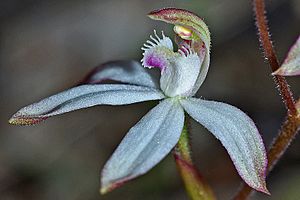Early caladenia facts for kids
Quick facts for kids Early caladenia |
|
|---|---|
 |
|
| Caladenia praecox growing near Clonbinane | |
| Scientific classification | |
| Genus: |
Caladenia
|
| Species: |
praecox
|
| Synonyms | |
Caladenia praecox, commonly called the early caladenia or early caps, is a beautiful plant from the orchid family. It is found only in south-eastern Australia. This orchid grows from the ground and has a single leaf. It produces up to four white flowers, which often have touches of green or pink.
What Does It Look Like?
The Early Caladenia is a perennial plant, meaning it lives for more than two years. It's also a deciduous herb, which means its leaves fall off at certain times. This plant grows from an underground tuber (a bit like a potato). It has one leaf that is about 60–120 mm (2–5 in) long and 2–3 mm (0.08–0.1 in) wide.
Its flowers grow on a stem (called a spike) that is about 60–130 mm (2–5 in) tall. You might see up to four white flowers on each spike. These flowers often have hints of green or pink. The back of the flower's sepals and petals have tiny, dark red hairs that look like glands.
The top sepal, called the dorsal sepal, is about 9–12 mm (0.4–0.5 in) long. It curves forward, forming a small hood over the flower's central part, called the column. The side sepals are 11–15 mm (0.4–0.6 in) long and spread out. The petals are 9–12 mm (0.4–0.5 in) long and also spread wide.
The most interesting part is the labellum, which is the orchid's special lip. It's white, often with red spots, and is about 6–7 mm (0.2–0.3 in) long. The sides of the labellum curve upwards and have small, stalked teeth. The very tip of the labellum curls underneath. In the middle of the labellum, there are four to six rows of crowded bumps called calli. These orchids usually bloom between August and October.
How It Got Its Name
The scientific name for this orchid, Caladenia praecox, was first officially described in 1926. This was done by a botanist named William Nicholls. His description was published in a journal called The Victorian Naturalist.
The second part of its name, praecox, comes from a Latin word. It means "too early ripe" or "precocious." This might refer to when the orchid flowers. Some botanists, like those at the Royal Botanic Gardens, Melbourne, consider C. praecox a proper name. However, others, like those at the Royal Botanic Gardens, Kew, think it's a synonym (another name) for Caladenia dimorpha.
Where Does It Grow?
The Early Caladenia is found across Victoria, especially in the Victorian goldfields. It's also often seen in areas north-east of Melbourne. This orchid prefers to grow in open forests and woodlands. You can also find it in the south-east part of New South Wales.
Is It Protected?
Currently, Caladenia praecox is not listed as an endangered or threatened species under Victoria's Flora and Fauna Guarantee Act 1988. This means it doesn't have special legal protection in Victoria, but it's still important to protect its habitat.

